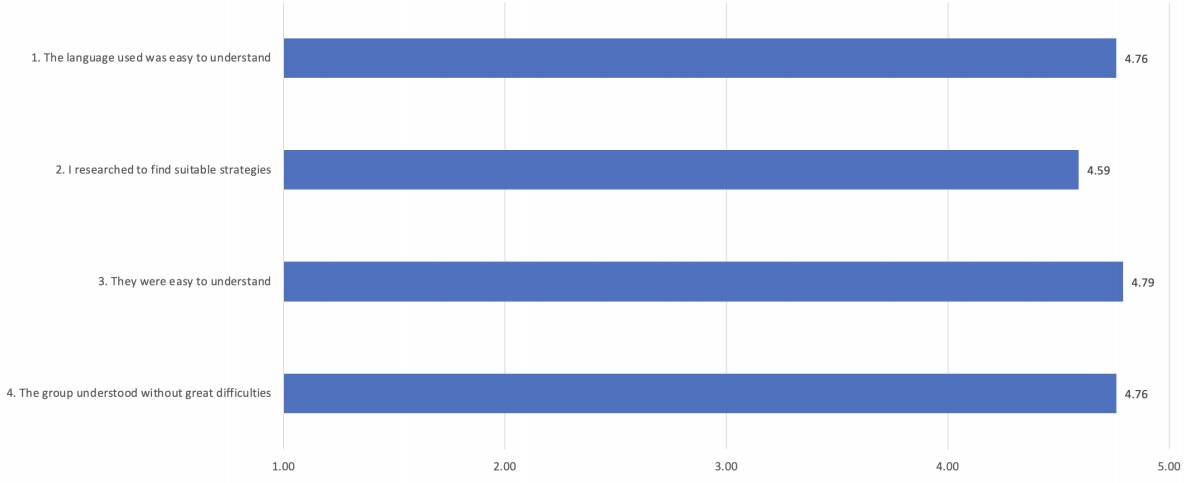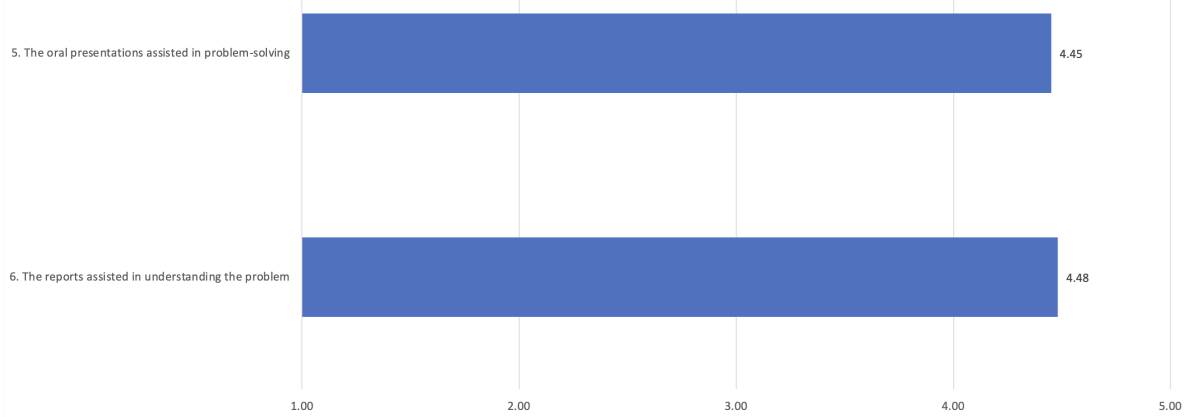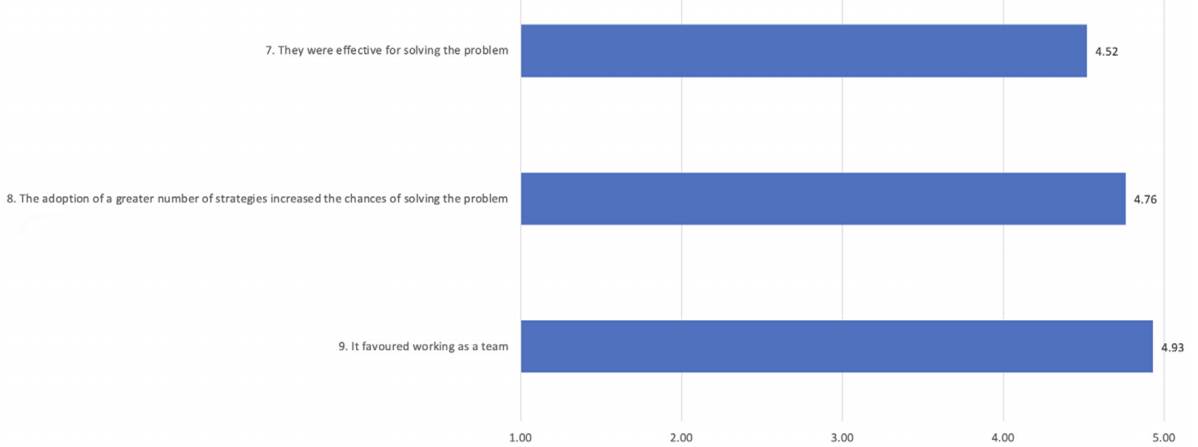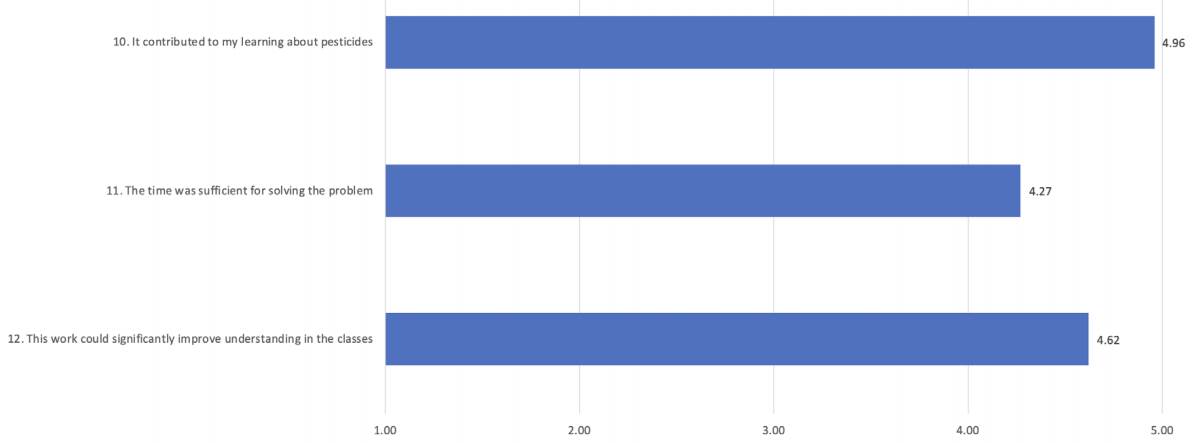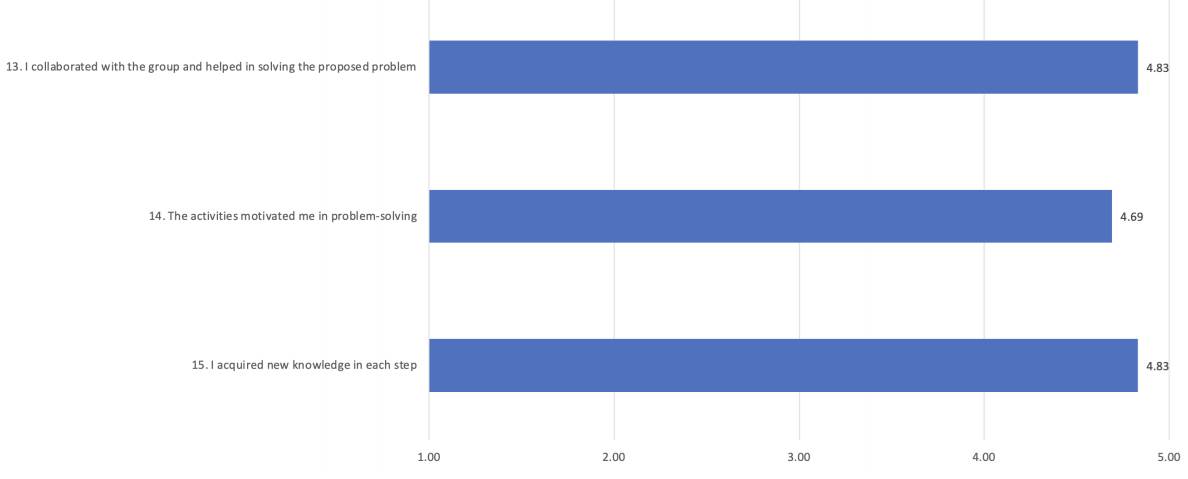Introduction
This paper provides an analysis of the problem-solving methodology implemented in chemistry technical education at the high school level, introducing the topic of pesticides, with specific problems and discussion appropriate to this educational level. The work focused on development of the main typologies of learning (Zabala, 1998), in relation to the environmental impacts caused by pesticides, making the students aware of the different stages and modalities of fundamental education concerning this environmental problem.
In Brazil, the professional trained as a chemical technician is scientifically and technologically qualified to work in chemistry and microbiology laboratories, in the control and monitoring of chemical industrial processes, in the quality control of raw materials and products, and in provision of technical services. These activities should be performed ethically and professionally, in accordance with established standards regarding safety and environmental protection (Ramm, et. al., 2018).
Considering the environmental research theme addressed here, there has been extensive industrial investment in the manufacture of chemical products for use in crop production, including a wide range of herbicides, insecticides, and fungicides. These pesticides are used during the cultivation, storage, and processing of crop products, as well as on pastures, in livestock production, in forestry, and in urban, aquatic, and industrial environments, with the aim of modifying the composition of the flora and fauna, consequently protecting crops and products from the action of organisms believed to be harmful (Zowada et al., 2020).
Considering this environmental problem, the skills that the chemical technician should have, and a methodology that favours teaching and learning processes, an interdisciplinary study (Pombo, 2008) was carried out involving classes in Chemistry and Portuguese, using a problem-solving activity to contextualize the theme of pesticides. The objective of this research was to evaluate the contributions of the teaching sequence to the development of conceptual, procedural, and attitudinal knowledge related to the environmental problems that pesticides can cause. We also report the students’ perceptions about the teaching and learning processes.
Theoretical background
As discussed by Zabala (1998), the function of the school is to provide the students with a holistic and integrated education, since the experiences lived at school are determinant factors affecting personal bonds and the conceptions of individuals regarding themselves and other citizens. Zabala (1998) describes what he calls learning contents, whose significance goes beyond the question of teaching, providing meaning in the question of why teaching is important, affecting all the dimensions of learning. Zabala (1998) characterizes the typologies of learning as follows: factual and conceptual (what should be learned?), procedural (what should one do?), and attitudinal (how should one be?). Concerning the concept of learning, Zabala (1998) considers that the learning process is favoured by activities in which new contents are linked to previous knowledge of the students. The activities should stimulate intense mental activity regarding these relationships, grant significance and functionality to new concepts and principles, and provide a challenge relevant to real possibilities. These educational approaches improve understanding of a concept, enabling it to be used to interpret or understand situations, or for the development of new ideas.
Given these considerations and the complexity of many chemical concepts, there is the need for a teaching process in which the student can learn how to learn, which becomes the focus of this process (Lima; Arenas; Passos, 2017; García; Cortés; Mejía, 2020). Having that in mind, we believe that one of the teaching methods most able to contribute to students’ learning processes is the problem-solving methodology. Some authors consider that this method encourages students to research the concepts they are studying, with emphasis on social engagement and focus on group work, enabling discussion by means of communication and argumentation (Pozo, 1998). Students are encouraged to analyse ideas, present activities that stimulate discussion, and debate about how things work, creating solutions for different aspects of a contextual problem that, in most cases, is distinguished from traditional models (Domin; Bodner, 2012; Martínez; Martínez Aznar, 2014). The problem-solving methodology uses open and suggestive questions, giving the students the opportunity to build their knowledge employing their own skills (Pozo, 1998; García; Cortés; Mejía, 2020).
This construction of knowledge can be related to the development of the students’ autonomy. According to Freire (2000), the principle of autonomy is related to the way in which an individual dialogically obtains the means to lead the course of his/her own history, acquiring critical and reflective characteristics. Freire (2000) understands that autonomy is the ability and freedom to build and rebuild what is taught. Although the concept of freedom is a relevant theme, Freire does not ignore the importance of the teacher, whose role, in his view, is not to transmit knowledge, but to create possibilities for students to build their own knowledge.
In Freire’s view, autonomy is essential for the construction of a democratic society, at the same time creating conditions for political participation, whereby citizens have a voice and opportunity to express themselves freely, indicating the type of society considered to be most suitable, from both individual and collective perspectives (Freire, 2000). We understand that Freire’s (2000) perspective encourages the use of investigative methodologies, such as the problem-solving methodology, because one of the great gaps in formal education is the fact that students are practically not stimulated to think autonomously.
Research methodology
This research was conducted using the case study method, which is a qualitative approach widely used in the educational context (Yin, 2009). The case study method allows for empirical investigation of a unique and well-defined context, which encompasses planning, various data collection techniques, and analysis (Yin, 2009).
The case study described in this work was undertaken with 29 students from the three grades of the chemical technician course (taught at night) at a public school in the city of Porto Alegre (Rio Grande do Sul, Brazil). All the participants signed a free and informed consent form.
The researchers assumed the role of researcher-teacher. Data were collected using the researchers’ field diaries, the written productions of the students, the questionnaires applied, and audio recordings of the class, which were analysed qualitatively and interpretatively. The questionnaire applied is available in the Supporting Information.
Pedagogical methodology
We analysed the use of the problem-solving methodology, contextualizing the subject of pesticides, their definition, purpose, consequences, chemical characteristics, and possible alternatives. The students experienced the problem-solving activity in the school auditorium, in one five-period class (lasting approximately five hours), to ensure that all the students participated in all phases of the study.
The three problems developed by the researchers addressed the environmental aspects of pesticides. We decided to formulate three semi-open and qualitative problems (Pozo, 1998; Lima; Arenas; Passos, 2017), to further the studies of the pesticide’s topic.
The first problem contextualized the contamination of Antarctic penguins with DDT, proposing an investigation of the potential environmental (including health) problems caused by pesticides. The students also researched the special precautions that farmers should take when using DDT and other pesticides. The second problem concerned the types of pesticides, their general characteristics, and identification of the functional groups found in the pesticides chosen by the students. The students also researched alternatives able to eliminate or reduce the use of pesticides. In the third problem, the students were asked to research about organic farming. The problems are shown fully in a previous study (Ribeiro; Passos; Salgado, 2020) and in the Supporting Information.
We used a teaching sequence consisting of six phases (Table 1).
Table 1 Teaching sequence.
| Phases (duration) |
Activities |
|---|---|
| I (30 min) | Introduction of the topic to the students using excerpts from two videos: O veneno está na mesa 1 (The poison is on Table 1) (YouTube, 2021a) and O veneno está na mesa 2 (The poison is on Table 2) (YouTube, 2021b). The researchers explained the environmental impacts that pesticides can cause, facilitating discussion with the students about the problems to be solved. |
| II (45 min) | Organization of the work teams into five groups of five people and one group of four, followed by reading and analysis of the problems. The problems were distributed as follows: groups 1 and 2 were given problem 1; groups 3 and 4, problem 2; and groups 5 and 6, problem 3. |
| III (60 min) | Discussion within the groups for the elaboration of working hypotheses, and reading of the materials available for consultation, which included books indicated by the Brazilian national textbook program for high schools. |
| IV (60 min) | Preparation of the presentations. All the groups produced written reports and gave oral presentations showing their solutions. |
| V (60 min) | Presentations of the solutions. |
| VI (45 min) | Collective debate, in which the teachers carried out a survey on the main problem-solving models and emphasized the fundamental concepts discussed. |
After the end of the didactic sequence, to complete the activities, a questionnaire was applied to evaluate the contribution of the problem-solving methodology to the students’ understanding of pesticides.
The teaching-learning sequence
In the introduction to the class, the Chemistry teacher questioned the students concerning the topic of pesticides. Some of the answers were as follows:
Pesticides are products used in cultivations to accelerate or increase productivity and make the product more attractive to the consumer.
Pesticides are poisons used in the environment to combat pests in agriculture.
The Portuguese teacher asked if they believed that pesticides are good for human beings and the environment, and to justify their answers The students were keen to respond and immediately raised their hands to participate in the discussion and provide their explanations, as shown in the example:
Pesticides are not good, since they contaminate food, soil, and workers.
The Chemistry teacher provided another question, asking if plants were healthier with or without pesticides, which resulted in the following answer:
Nature, by itself, does not require poisons. Before pesticides existed, nature and human beings never needed poisons.
In this way, when the researchers started the work, leading questions were used to identify the students’ prior knowledge about pesticides. Based on this information, it was then possible to determine the extent to which the experience of the problem-solving methodology contributed to learning of the conceptual contents (Zabala, 1998).
In this initial discussion about pesticides, it was evident that some of the students considered these chemicals to be poisons that can harm the environment. However, other students were unaware of the high pollution potential that pesticides can have in many environmental matrices (Zowada et al., 2020).
Pesticides are used profusely, driven by agribusiness, and this exaggerated use causes damage to the environment and to human health. Therefore, an awareness effort is necessary to alert people about the risks associated with the consumption of foods containing high levels of pesticides, as well as about the harm these chemicals can cause to the environment and animals, as evidenced by research on this subject (Zowada et al., 2020).
Raising awareness about the dangers that pesticides can present to the environment is relevant for future chemical technicians (Ramm et al., 2018), since these professionals must always be concerned with the preservation of the environment. A fundamental aspect of this work is the need to act with environmental responsibility and in compliance with existing technical and quality standards, as well as good manufacturing and safety practices.
In Phase I and Phase II, the teachers talked about pesticides and the environmental problems these chemicals can cause, and brought several examples. The students showed great interest and were attentive to the information conveyed in the videos. Analysis of the field diaries and of the audios showed that the students had no difficulties in understanding the problems and that they searched for information in the selected bibliography.
In the discussion (Phase III), the students showed interest in the task, since after reading the proposed problems, they discussed and exchanged ideas, in addition to reporting personal experiences related to the issues that they were trying to solve. As the students worked, the researchers helped the groups with their doubts, giving them advice when necessary. In this type of approach, the role of the teacher is fundamental in guiding the process of knowledge acquisition, with greater interaction between the teacher and the students enhancing the teaching and learning processes (Lima; Arenas; Passos, 2017).
This approach is coherent with the views of Freire (2000) regarding the teacher’s role in the classroom. The teacher’s active role favours the development of the students’ autonomy for decision-making and solving problems that can arise in their daily lives. A student who has autonomy is a proactive individual who is able to more easily and satisfactorily solve problems, both inside and outside of the school, and to be critical in terms of thought and action (Martínez; Martínez Aznar, 2014; Silva; Lins; Leão, 2019). While developing autonomy, the student, together with their classmates and the teacher, takes responsibility for learning. The students should be able to organize themselves, developing study methods such as taking notes, researching support materials, and preparing reports (Domin; Bodner, 2012; Silva; Lins; Leão, 2019). They need to manage their time, setting priorities for carrying out tasks; be reflective and critical when facing problems, testing solutions and making choices; and use the available material and several sources of information.
The analysis of Phase IV and Phase V was based on the audio recordings of the group presentations, the notes in the field diaries, and the reports of the problems’ solutions.
Group 1 did not talk about the health problems that pesticides can cause, but presented a coherent solution that focused on other points of the problem. One of the members of this group started an enthusiastic discussion, because he initially advocated the controlled use of pesticides in certain circumstances. However, during the discussions, this student realized that sustainable practices, without the use of pesticides, would be better than others using these substances even in small quantities.
Group 2 solved all the items of problem 1 in a satisfactory manner. Groups 3 and 4 worked with problem 2, developing appropriate solutions, without any difficulty. They researched about the general characteristics and chemical structures of classes of pesticides widely used in Brazil, including pyrethroids, carbamates, organophosphates, and organochlorines. They also looked for sustainable agricultural alternatives.
Groups 5 and 6 proposed complete and pertinent solutions to problem 3, concerning organic agriculture, its characteristics, and cultivation practices.
In the open discussion (Phase V), the students assessed the similarities and differences of the proposed solutions. Subsequently, the researchers summarized the main issues discussed throughout the investigation, such as the harm caused by pesticides. The teachers also reviewed the presentations with the whole class, identifying positive aspects and areas that could have been better developed. To finish the class, the chemistry teacher again asked the same questions from the introduction. The new answers showed that the students understood that pesticides are harmful to humans, animals, and plants, and that they can contaminate environmental matrices.
It was observed that the problem-solving methodology was closely linked to the students’ autonomy, which is the ability to self-govern, to make one’s own decisions, and to be critical and reflective. About the construction of autonomy, Freire (2000, p. 121) states that it needs “to be centred on experiences that stimulate decision and responsibility, that is to say, on experiences that respect freedom”. The results suggested that the activity undertaken in the present work contributed to the development of students’ critical thinking, enabling them to contribute to the world around them in a more collaborative and positive way. Teachers must be able to motivate students, involving them and enabling them to develop the skills to act, think, and present opinions, leaving aside, whenever possible, traditional ways of transmitting content. As stated by Freire (2000), the function of the school is not just to present its students with information, but rather to encourage their independence, autonomy, and creativity.
The guiding references of this research (Zabala, 1998; Freire, 2000) stress the necessity of providing opportunities in which students participate intensively in the activities and in the process of personal growth, instead of restricting themselves to automatically copying and reproducing the instructions or explanations of the teachers. Therefore, in this process of autonomy, we believe that it is the teacher’s task to mediate and guide learning, as in the present study. During the activity, we observed the development of the attitudinal concepts of autonomy and criticality in the discussions started by the students. We also observed the development of procedural concepts in the raising of hypotheses for solution of the problems, in the discussions related to their experiences brought to assist them in the solutions, in the research using different sources, in the production of the reports, in the oral presentations of the solutions, and in the final debate.
The students’ perceptions
The students’ evaluations of the activity were obtained using the questionnaire applied after the teaching and learning processes. One of the first questions was about the contributions of using the problem-solving methodology in the classroom. All 29 participants said that they enjoyed working according to this pedagogical approach. Six students expressed how the methodology helped them to “improve their thinking” and “reflect on the subject”, as illustrated by the following answer:
It helped in developing another way of thinking about the subject addressed, not only explaining it, but also looking for ways to solve it.
Some researchers (Martínez; Martínez Aznar, 2014; Lima; Arenas; Passos, 2017) attribute a function of the type “engine of the act of thinking” to activities using the problem-solving methodology, considering the didactic activities of problem-solving as being fundamental in promoting the students’ learning of sciences. Still in the first question, three students believed that group work and respect for different opinions assisted the teaching and learning process:
Yes, because it stimulated collective research, using different points of view, and then arriving at a conclusion.
Among the answers regarding the students’ acceptance of the problem-solving methodology, one of the students indicated that by contextualizing the theme, starting from a problem, the construction of knowledge was more evident:
Yes, because from a given problem it becomes easier to understand, assimilate, and generate interest about what has been or will be studied.
The closing question of the questionnaire asked for the degree of agreement of the students on the ways the problem-solving methodology might have contributed to their development, using a Likert scale, where 1 = CD (completely disagree), 2 = PD (partially disagree), 3 = U (undecided), 4 = PA (partially agree), and 5 = A (agree). Calculation of the agreement value consisted of adding up the number of times the option was chosen, multiplying by the score assigned to it, and dividing by the total number of answers.
As shown in Figure 1, most of the students found that the problems and the language used were easy to understand, and were able to perform the necessary research to develop appropriate strategies. The investigation showed that the students had little difficulty in understanding the suggested problems concerning pesticides.
Regarding the oral presentations by the groups and the written reports, most of the participants agreed that they contributed to solving the problems, and that the written reports assisted their understanding (Figure 2).
As shown in Figure 3, the students found that the strategies used by the group were effective in solving the problems. They reported that the adoption of a greater number of strategies increased the chances of success in obtaining appropriate solutions. Furthermore, the students believed that these methods contributed to successful teamwork.
Figure 4 shows the opinions of the students concerning working according to the problem-solving methodology. The students agreed that the technique contributed to their learning about the topic of pesticides and the environment. In addition, they considered that the time allowed was sufficient for solving the problems and that the methodology favoured learning and could significantly assist their understanding.
As shown in Figure 5, the students believed that they were able to assist the other group participants, actively participating in solving the problems and feeling motivated to undertake the tasks. They also believed that they acquired new knowledge during the problem-solving procedures.
The answers provided by the students indicated their belief that the problem-solving methodology contributed to their learning. There were three main contributions: conceptual improvement on the pesticides environmental theme; attitudinal improvement regarding awareness of the risks and harms associated with the use of pesticides; and procedural improvement related to undertaking research and developing hypotheses to solve the problems. Overall, the results demonstrated that the group work assisted the students’ education, since it required social interaction and the development of hypotheses and knowledge in a dialogical and critical way.
Conclusion
The results, which were convergent to other research in the area (Martínez; Martínez Aznar, 2014; Lima; Arenas; Passos, 2017), showed that the teaching sequence favoured conceptual learning, related to scientific knowledge on the topic, and procedural learning, such as the analysis of bibliographic references, the production of reports, and the defence of ideas during oral presentations. It was observed that the students also developed attitudinal knowledge associated with awareness of the environmental problems that pesticides can cause, relating this issue to political, environmental, social, and economic factors. By making the relation of the topic to their reality clear, it was possible to make the study about pesticides relevant and motivating. We believe that we accomplished our objective in this research, especially since during the presentations, we saw that the participants understood that pesticides are dangerous for the environment and, consequently, for the health of living beings. Learning experiences such as the one described here can bring students into closer alignment with their future professional activities, favouring understanding of the role of the chemical technician in society, while encouraging autonomy and entrepreneurship.
With this study, we hope to disseminate a methodology that is known in the academic sphere for its potential to assist in the processes of teaching and learning scientific knowledge, but is still rarely adopted in Brazil in the context of basic and higher education in the Chemistry area. We believe that the problem-solving methodology provides an investigative approach to learning, where the teacher acts to guide conceptual construction, based on the ideas and proposals of the students for solving problems. Therefore, we hope that the results obtained in this research may form the basis for new studies by researchers and lecturers in the area of Chemistry, with the aim of developing teaching and learning processes founded on collaboration, reflection, and autonomy.











 nueva página del texto (beta)
nueva página del texto (beta)

